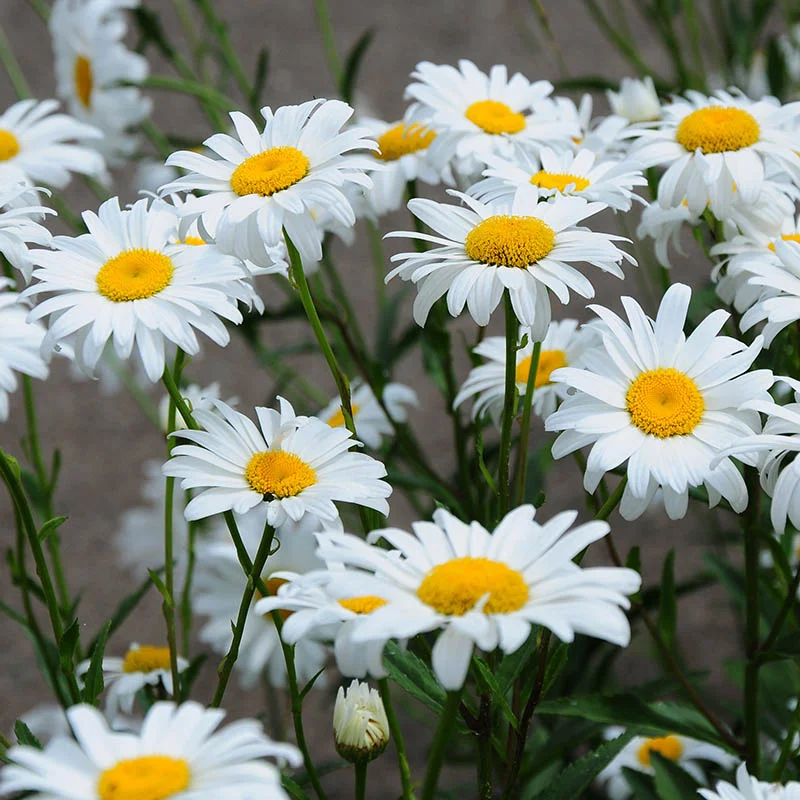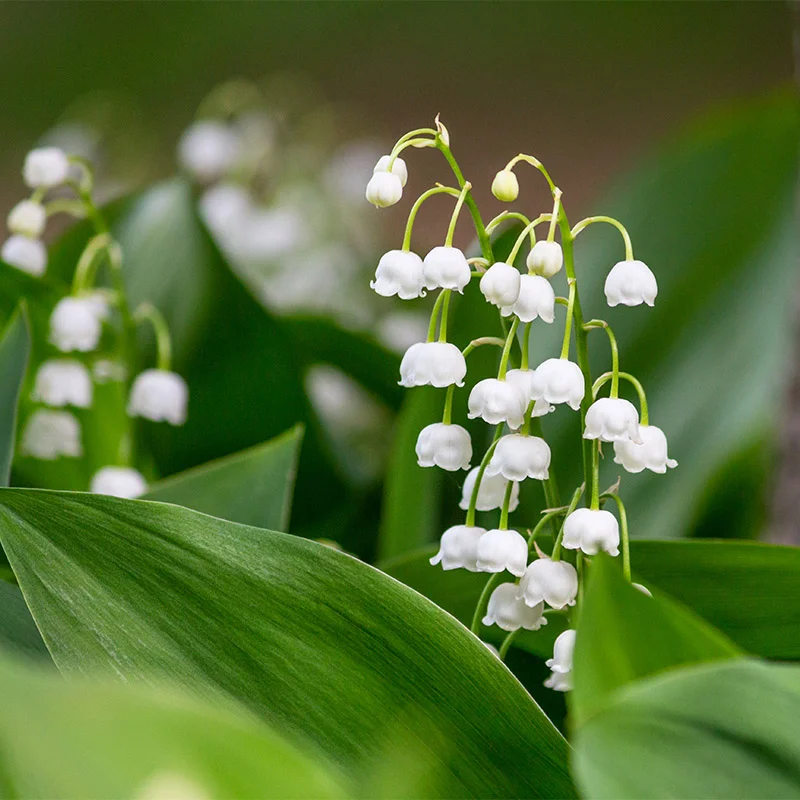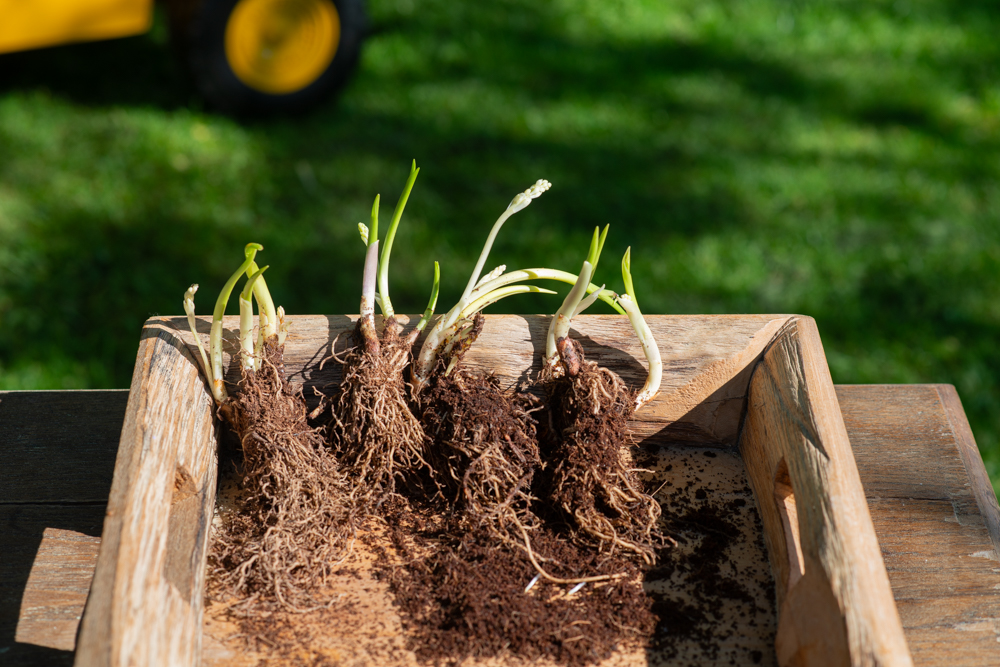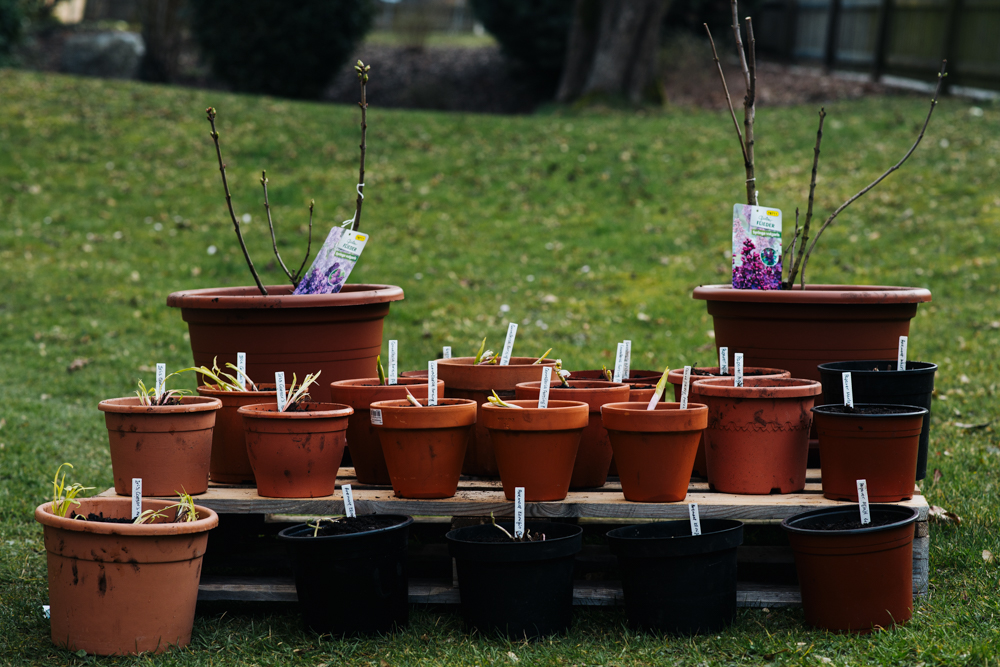Your cart is currently empty!
Category: Roots
-

Why are perennials practical?
Perennials are long-lasting herbaceous plants that produce new shoots each year. Unlike shrubs and trees, they do not become permanently woody. In winter, their above-ground parts often die off, but in spring they grow back from roots or tubers.

Characteristics of perennial plants
- Strong and resilient
- Since perennials live for several years, you won't have to replant them every year - this saves time and money.
- Variety of colors and shapes
- There is a huge selection of perennials: flowering, evergreen, groundcover and tall varieties.
- Many bloom for a long time or even several times a year.
- Ecologically valuable
- Perennials such as lavender, echinacea, and sage are an important food source for bees, butterflies, and other pollinators.
- Low operating costs
- Most perennials are hardy, require little watering, and only need pruning in the spring or fall.
- Universal use
- Ideal for flower beds, rock gardens, wildflower meadows or as a groundcover
- There are perennial plants for sunny and shady places.
- Beautiful even in winter
Perennials make a garden easy to maintain, resilient and vibrant - a great choice for any garden, novice gardeners and professionals alike.
-

Bare-rooted plants
One of the biggest advantages of bare-root plants is the ability to easily assess their freshness and health. Bare-root plants cannot be stored for a long time, unlike plants that are already sold in containers. Therefore, if we buy bare-root plants, it means that they are fresh.
We offer a small selection of bare root plants, each plant has its own delivery time, as the freshness of our products is important to us, we do not order roots in large quantities and do not store them for a long time.
There are a number of advantages that make bare root plants a popular choice when planting and transplanting:
1. Economicalt
- Roots are usually cheaper than closed root plants (in pots or containers) because they do not require the cost of soil, containers and additional packaging materials.
2. Ease of transportation
- The absence of heavy soil makes bare-root plants easier to transport.
3. Easy inspection of roots
- Exposed roots can be easily checked for health, damage or disease before planting. This helps avoid transplanting diseased plants.
4. Better rooting
- Such plants adapt to new soil faster, since their root system immediately begins to interact with the surrounding soil.
5. Comfortable fit
- Roots can be planted at any convenient time during the season (usually fall or early spring) while the plant is dormant.
6. Eco-friendliness
- The absence of containers and minimal packaging makes this method more environmentally friendly.
Flaws
However, it is worth considering that plants with an open root system require proper handling and timely planting. The roots can dry out if they are not moistened before planting.
When planted correctly, bare root plants can be a great choice for your garden for years to come!
Here's how to determine the freshness of such plants:
1. Appearance of roots
- The roots must be moist, elastic and light (white or light brown). If they are dry, dark, or look dead, the plant is probably not fresh.
2. No damage
- The roots should not have any rotten or soft areas, cuts or signs of fungal damage.
3. State of shoots
- The shoots and branches of the plant should also be healthy: no cracks, mold or dry ends
4. Elasticity
- If you bend a root or branch slightly, it should be flexible and not break.
5. Smell
- The roots and the plant itself should smell like fresh earth. If there is an unpleasant smell of decay, this is a bad sign.
6. Packaging (upon purchase)
- If you buy exposed roots, check that they have been stored properly: the roots should be wrapped in a damp material (such as moss, sawdust, or sprinkled with peat) to prevent them from drying out.
7. Reaction to water
- If the plant seems a little dry, you can put the roots in water for a few hours. Fresh roots quickly absorb moisture and restore elasticity.
Regular inspection before planting will help avoid problems and ensure that the plants are healthy and thrive!
We wish you successful plantings!
-

Lilies of the valley
Lily of the valley (lat. Convallaria majalis) is an elegant perennial plant known for its white bell-shaped flowers and pleasant aroma.
Origin of the name
Latin name Convallaria majalis translates as "May lily of the valleys", reflecting its natural habitat - shady forest valleys.
Who gave the name "lily of the valley"?
The Slavic name "lily of the valley" is considered to be derived from the Polish word "lęda", meaning "lowland" or "wasteland." This reflects the natural habitat of the lily of the valley - shady, low-lying wooded areas.
The Latin name of the plant is Convallaria majalis – was officially introduced by Carl Linnaeus in the 18th century.
- Convallaria comes from Latin "convallis" - "valley".
- Majalis means "May", indicating the flowering period of the plant.
Together, the name can be translated as "May lily of the valleys."
In English, lily of the valley is known as "Lily of the Valley" (Lily of the Valleys). This name, like the Latin name, emphasizes the place of growth of the plant and its similarity to lilies.
Lily of the valley also has a poetic connotation in English culture. In the Victorian language of flowers, it symbolized the return of happiness and tenderness.
Historical facts and symbols
Lilies of the valley are an amazing plant with a rich history and interesting features.
Lily of the valley is mentioned in the myths and folklore of many peoples. In ancient Greek mythology, it was associated with the goddess Diana, and in the Christian tradition it is considered a symbol of purity and modesty.
Lily of the valley symbolizes tenderness, love and rebirth, and is also widely associated with spring.
Myths and Legends
- Greece: Lily of the valley was considered a gift from the god Apollo. He supposedly grew it to shelter the nymphs from the scorching sun.
- Christianity: According to legend, lilies of the valley grew from the tears of the Virgin Mary when she mourned the crucifixion of Christ. That is why it is called "the tears of the Virgin Mary."
- Europe: The French associate the lily of the valley with the May Day holiday, which has become a symbol of good luck and love.
Cultural significance
- In England, lily of the valley is called "May lily"
- In Finland, the lily of the valley is the national flower
- In the Victorian era, lilies of the valley symbolized the "return of happiness"
Interesting facts
- Poisonous plant:
All parts of the lily of the valley contain toxic substances - cardiac glycosides. They can be dangerous for humans and animals if ingested. - Medical use:
In ancient times and in modern medicine, lily of the valley was used to treat heart disease, as well as a diuretic. - Perfumery:
The natural scent of lily of the valley is highly prized, but it is difficult to extract from the flowers. Therefore, a synthetic version is used in modern perfumery - Bloom:
Lily of the valley blooms in May-June, and each brush can contain from 5 to 15 flowers. It is one of the earliest spring plants - Ecological role:
Lilies of the valley prefer to grow in the wild – in shady forests and forest edges. They are resilient and can form dense carpets. - Varieties and varieties:
There are decorative varieties with double flowers, variegated leaves or unusual shades (for example, pink lilies of the valley).
Planting with roots
- Select a location: Lilies of the valley prefer shady or semi-shady areas. The ideal soil is moist, rich in organic matter and well-drained.
- Preparing the roots:
- Purchased or dug up rhizomes should be checked for freshness and damaged areas should be removed.
- If desired, you can soak the roots in warm water for 2-3 hours before planting.
- Landing:
- Plant the rhizomes at a depth of 2-3 cm, leaving the tops of the buds at ground level.
- The distance between plants is 10–15 cm.
- Landing time:
- Lily of the valley roots can be planted almost all year round.
Care
- Watering:
- Lilies of the valley love humidity, but do not tolerate stagnant water. Regular watering is especially important during the growing season.
- Top dressing:
- Apply organic fertilizer or compost in the spring.
- In mid-summer, you can add complex mineral fertilizer.
- Reproduction:
- Lilies of the valley grow quickly. To control this, replant the plants every 3-4 years.
- Divide the rhizomes in the fall or spring.
- Preparing for winter:
- Lilies of the valley are frost-resistant, but in regions with severe winters, cover the area with a layer of mulch or peat
- Pest Control:
- The main enemies are slugs and nematodes. Use organic products or special preparations.
- Lilies of the valley do not tolerate heat: Lily of the valley can live for decades, provided it is kept in a cool environment. It can withstand temperatures as low as -11°C. If you are growing the plant in a hotter climate or during the summer, it is important to give this plant shade. Shade is vital in the afternoon when temperatures are at their peak.
-

Perennials
Perennials are an important part of the plant world because they have unique characteristics that allow them to survive adverse conditions and delight with their beauty or usefulness for many years. They do not die after one cycle of flowering and fruiting, like annual or biennial plants, and are able to survive several growing seasons.
Main characteristics of perennial plants
- Long life cycle: Can live for decades or even centuries
- Ability to overwinter: Most often, perennials have underground organs (rhizomes, bulbs, tubers) that are preserved in winter, and in the spring the plant grows back
- Diversity of speciesAmong them are herbs, shrubs and trees.
- Easy to care for: They require less effort in terms of planting and replanting, as they do not need annual sowing.
Perennials are widely used in gardening due to their ability to decorate the garden for a long time without the need for annual replanting.
Perennials are a large group of plants, in the wild perennials form the basis of most ecosystems, including forests and steppes.
Examples of perennial plants:
- Flowers: peonies, irises, lilies, roses, lilies of the valley
- Shrubs: lilac, currant, rosemary
- Trees: oak, maple, apple.
- Vegetables: asparagus, rhubarb.
- Herbs: mint, lemon balm, thyme.
Benefits of Growing Perennials
- Durability: Once planted, they can live for years without replanting.
- Saving time and resources: Do not require annual sowing
- Variety of colors and shapes: Perennials offer a wide variety of plants for any type of garden.
- Winter hardiness: Many of them are adapted to harsh winters
- Pest resistance: Often less susceptible to disease than annuals
Planting perennials
- The best time to plant perennials is spring or fall.
- It is necessary to take into account the plant's preferences for sun, shade and soil type.
- Soil preparation:
- Dig the area to a depth of 10 to 30 cm, depending on the type of plant, remove weeds and add organic fertilizers.
- Digging a hole:
- The hole should be slightly wider and deeper than the root ball of the plant.
- Planting:
- Position the plant so that the root collar (the place where the stem meets the roots) is at ground level.
- Cover the roots with soil, tamp lightly and water.
- Distance between plants:
- Allow enough space for growth, usually between 20 and 50 cm, depending on the plant species.
Caring for perennial plants
- Watering
- Regular watering is necessary in the first year after planting. Once established, most perennials become drought-resistant.
- Top dressing
- In spring, it is recommended to use nitrogen-rich fertilizers for active growth.
- In autumn, phosphorus and potassium fertilizers are suitable for strengthening the root system.
- Trimming
- Faded flowers and dead leaves should be removed promptly to stimulate further growth.
- In the spring: Remove old foliage and dead stems to encourage growth.
- In summer: Cut off faded flowers to prolong flowering.
- In the fall: Prune the above-ground portion of herbaceous perennials (if necessary).
- Wintering
- To protect against frost, plants can be mulched, covered with spruce branches or agrofibre.
Tips for Successful Growing
- Renew your plantings regularly:
- Some perennials (such as irises) require division every 3 to 5 years to maintain health and abundant flowering.
- Mixed plantings:
- Combine perennials with different bloom times for a continuous decorative effect.
- Protection from pests and diseases:
- Prevention: observe crop rotation, remove plant debris in the fall.
- Use biological or chemical agents if necessary.
We wish you successful planting! May your garden delight you with its beauty and lush flowering!
We will be happy to answer your questions if any. Just leave your comment below the article.
